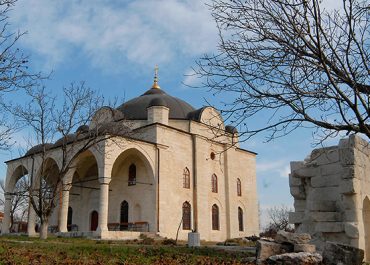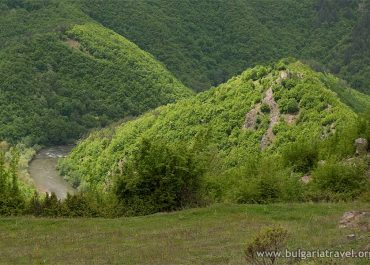
The Kardzhali Regional Historical Museum
The Kardzhali Regional History Museum is housed in a stately building constructed at the beginning of the 20th century. The museum looks out on a lovely park that is home to over 30 plant species native only to Bulgaria. The museum site was originally intended as an Islamic religious school (a medrese), but it never served in that capacity. From 1934-1947, it was used for military purposes. After that, it became a secondary school and then a campus affiliated with Plovdiv University. It was gradually converted to a museum between 1980 and 1983. In 2005, by order of the Ministry of Culture, the museum building was declared a nationally important architectural landmark.
The exhibition halls are on three floors that have a combined surface of 1,300 square meters. On the first floor, nine halls trace the development of life in the region from the 6th century BCE to the Middle Ages. Of particular interest is a community burial site from the Neolithic Age, photos of other rock burial sites, sanctuaries, sacrificial slabs, Roman pottery, jewels and artifacts from Christian tombs, and so forth.
On the second floor, there are four halls showing the natural habitats of the Eastern Rhodopes. Here are petrified fossils of oysters, snails, sea urchins, sea stars, coral, trees, and even fish. There are also medicinal plant collections, ore-bearing minerals, and photos of unique rock formations resembling a haystack, mushrooms, an elephant, and stone forests. There are photos of fractured alpine landscapes caused by shifting tectonic plates, among illustrations of other natural wonders.
On the third floor, there is an ethnographic exhibition that takes up in ten rooms, with displays from the 19th and 20th centuries. Here visitors can observe the region’s characteristic activities, such as agriculture, herding, coal mining, metalworking, shoemaking, sewing, weaving, and making cloth on a loom. There are also installations displaying the traditional folk celebrations and customs of inhabitants living in the Kardzhali region.
Opening hours of the ticket office: 09:00 – 16:30
Summer working hours
Tuesday – Sunday: 09:00 – 18:00
Winter working hours
Tuesday – Saturday: 09:00 – 17:00
Museum guided offer tours in Bulgarian, English, and Russian.
Tourist Information Center – Kardzhali
Monday – Friday: 08.00 – 17.00
Park “Prostor”, Stadium “Arena Arda”
Tel.: +361 22719
E-mail: info@kardjali-tourism.info
Website: http://www.kardjali-tourism.info/en
Тel.: +361/635 84
Website: https://www.rim-kardzhali.bg
The Kardzhali Regional History Museum is housed in a stately building constructed at the beginning of the 20th century. The museum looks out on a lovely park that is home to over 30 plant species native only to Bulgaria. The museum site was originally intended as an Islamic religious school (a medrese), but it never served in that capacity. From 1934-1947, it was used for military purposes. After that, it became a secondary school and then a campus affiliated with Plovdiv University. It was gradually converted to a museum between 1980 and 1983. In 2005, by order of the Ministry of Culture, the museum building was declared a nationally important architectural landmark.
The exhibition halls are on three floors that have a combined surface of 1,300 square meters. On the first floor, nine halls trace the development of life in the region from the 6th century BCE to the Middle Ages. Of particular interest is a community burial site from the Neolithic Age, photos of other rock burial sites, sanctuaries, sacrificial slabs, Roman pottery, jewels and artifacts from Christian tombs, and so forth.
On the second floor, there are four halls showing the natural habitats of the Eastern Rhodopes. Here are petrified fossils of oysters, snails, sea urchins, sea stars, coral, trees, and even fish. There are also medicinal plant collections, ore-bearing minerals, and photos of unique rock formations resembling a haystack, mushrooms, an elephant, and stone forests. There are photos of fractured alpine landscapes caused by shifting tectonic plates, among illustrations of other natural wonders.
On the third floor, there is an ethnographic exhibition that takes up in ten rooms, with displays from the 19th and 20th centuries. Here visitors can observe the region’s characteristic activities, such as agriculture, herding, coal mining, metalworking, shoemaking, sewing, weaving, and making cloth on a loom. There are also installations displaying the traditional folk celebrations and customs of inhabitants living in the Kardzhali region.
Opening hours of the ticket office: 09:00 – 16:30
Summer working hours
Tuesday – Sunday: 09:00 – 18:00
Winter working hours
Tuesday – Saturday: 09:00 – 17:00
Museum guided offer tours in Bulgarian, English, and Russian.
Tourist Information Center – Kardzhali
Monday – Friday: 08.00 – 17.00
Park “Prostor”, Stadium “Arena Arda”
Tel.: +361 22719
E-mail: info@kardjali-tourism.info
Website: http://www.kardjali-tourism.info/en
Тel.: +361/635 84
Website: https://www.rim-kardzhali.bg
Virtual map
Photos
© All images, advertising and video materials and/or other information published on this website are property of the Ministry of Tourism and are protected by the Law on Copyright and Related Rights, according to the Bulgarian laws to all applicable international and relevant acts of the European Union.





